Discovering Rare Birds: A Deep Dive into Avian Wonders
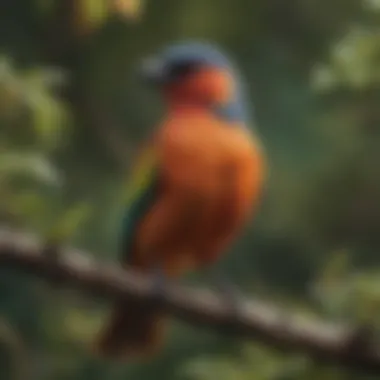
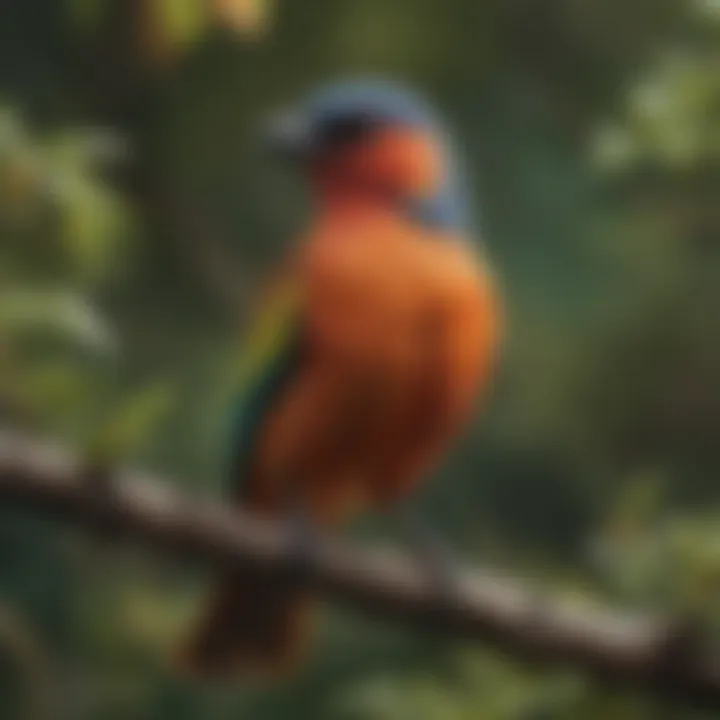
Intro
Birds have long fascinated humans, representing a captivating mix of beauty, diversity, and complexity. Among all avian species, unusual birds stand out not only for their quirky appearances but also for their remarkable adaptations and ecological significance. This article embarks on a journey into the world of these rare feathered creatures, aiming to deepen understanding in both enthusiasts and professionals alike. By weaving together aspects of personality, environmental needs and survival strategies, we aim to show how these birds really are vital players in our ecosystems.
Unusual birds, from the flamboyant bird of paradise to the elusive Kakapo, represent just a fraction of the diverse avian population. Their existence pushes us to consider the implications of biodiversity and what it means for the health of our planet. These birds often face numerous challenges, including habitat loss and climate change, underscoring the necessity of conservation efforts that extend beyond mere observation.
Through studying these creatures, we uncover not just their role in nature but the intricate web of relationships among species. This article ultimately serves a dual purpose: to highlight the enchantment these birds bring to our world, and to underline the critical conservation issues that keep bird populations struggling. By the end, readers will grasp the importance of safeguarding these unique species as part of a broader environmental narrative.
Prolusion to Unusual Birds
Birds are among the most visible and diverse creatures on Earth, yet some species stand out not just for their beauty, but for their peculiar characteristics and behaviors. The study of unusual birds opens a door to understanding the richness of avian life, and the important roles these species play within ecosystems. In this section, we'll explore what defines these extraordinary birds and why delving into their lives is crucial for both scientific discovery and environmental stewardship.
Defining Unusual Birds
The term "unusual birds" can evoke images of vibrant, rarely seen, or downright strange species. But defining these avian anomalies doesn't merely hinge upon appearance or scarcity. Instead, it encompasses a range of traits that set them apart from more common birds. For instance:
- Unique Physical Features: Unusual birds might flaunt bizarre bill shapes, striking plumage patterns, or peculiar sizes. Take, for example, the Resplendent Quetzal, known for its vibrant green feathers and long tail. Its beauty is not just a feast for the eyes but plays a vital role in its ecosystem, contributing to seed dispersal.
- Behavioral Traits: Many strange avian behaviors also come into play. Consider the Sandhill Crane, which engages in elaborate dancing displays as part of its courtship rituals. The unique mating systems or feeding habits often capture the interest of ornithologists and nature enthusiasts alike.
Unusual birds are those that challenge our understanding of avian biology and ecology. Their lives tell stories of survival, adaptation, and the intricate web of life in which they exist.
Importance of Studying Unique Avian Species
- Biodiversity Insights: Each unusual bird species contributes to the tapestry of life, shining a light on how biodiversity functions and thrives. The interactions between different species—including unusual birds—can exhibit complex ecological relationships. For instance, the relationship between the Himalayan Monal, which feeds on various insects and roots, and the plants it thrives upon underscores the interdependence within an ecosystem.
- Conservation Messages: Unusual birds often serve as indicators of environmental health. Changes in their populations may signal shifts in habitat quality, climate change effects, or other ecological disturbances. Understanding these birds helps in crafting better conservation strategies, allowing researchers to address declines in bird populations and the broader ecosystems.
- Cultural Connections: The fascination with unusual birds extends into cultures around the world. From the sacred *Kākā to the Shoebill, these birds carry significance in art, folklore, and tradition. Recognizing these connections not only enriches our appreciation for them but also aids in the preservation of cultural heritage linked to avian species.
Characteristics of Unusual Birds
When we talk about unusual birds, it’s not just about their striking look or quirky behaviors. The uniqueness of these avian species can often be traced back to distinct characteristics that set them apart from more common types. This section importantly highlights how these characteristics—both physical and behavioral—form a crucial foundation in our understanding of avian diversity and adaptability. Recognizing these traits allows ornithologists and bird enthusiasts alike to appreciate biodiversity and promotes the crucial need for conservation efforts.
Physical Attributes
Physical attributes of unusual birds are vital as they often reveal adaptations that have developed through various environmental pressures and ecological needs. Let’s dive deeper into two significant aspects: coloration variations and body size and structure.
Coloration Variations
Coloration variations in birds can be quite remarkable. This is not just for show; these colors play significant roles in camouflage, mating rituals, and even temperature regulation. For instance, the vibrant plumage of the Scarlet Macaw not only dazzles the eye but serves as a signal of health and vitality during mating season. The bright reds and blues can attract potential mates while also providing some protection against predators in the lush canopies of their rainforest homes.
Another interesting point is that these color variations can also signify different genetic health levels. Birds with vivid colors are often perceived as strong and fit, thus attracting mates more easily. Conversely, birds that lack these vivid hues may face challenges in reproduction, as they might be seen as less viable. Coloration variations bring advantages by enhancing survival and reproduction opportunities, making it a compelling topic in the study of unusual birds.
Body Size and Structure
Moving on to body size and structure, this characteristic offers insights into a bird's lifestyle and evolutionary adaptations. For example, the Himalayan Monal, known for its intricately shaped body, is not only stunning but is also perfectly built for moving through steep and rocky terrains of the Himalayas. Its compact structure allows it to navigate rugged environments where many other birds would struggle.
Additionally, the differences in body size can correlate with ecological roles. Smaller birds might excel at sneaking into nooks for food, while larger birds like the Bald Eagle may be designed for soaring at higher altitudes, giving them a grand vantage point. This keyword—body size and structure—is indicative of a bird's ecological niche, showcasing why it’s an essential factor when exploring unusual birds.
Behavioral Traits
Behavioral traits often include fascinating rituals and feeding habits that play significant roles in the survival and adaptation of these species. This section shines a light on unique mating rituals and feeding habits that further define and differentiate unusual birds.
Unique Mating Rituals
Mating rituals among birds can be as colorful as their feathers. For instance, in the case of the Bird of Paradise, males perform elaborate dances, showcasing their vibrant plumage, to entice females. Not only does this display attract mates, but it also signals to rivals about the male's fitness and genetic quality. Such rituals can leave observers in awe, but they also serve a critical evolutionary purpose, enhancing reproductive success.
These unique mating rituals can be seen as a communicative dance; the way a bird struts, spins, and displays can significantly affect its attractiveness. However, these behaviors also come with risks—elaborate displays can attract not just mates but also potential predators. Thus, the interplay between attracting mates and avoiding danger is a delicate balance that unusual birds constantly navigate.
Feeding Habits
Feeding habits also tie back into the uniqueness of these birds. Many unusual birds have developed specialized feeding techniques that accommodate their diets. Take the Puffin, for example. Their feeding habits involve adept diving skills and the ability to carry multiple fish in their beaks while swimming back to their nests. This unique feature showcases their evolutionary specialization—advantageous for survival in the often-competition-heavy ecosystem of the ocean.
From nectarivorous species like the Hummingbird, which feed almost exclusively on nectar, to raptors that scavenge or hunt prey, these feeding habits reflect adaptability in various environments. Understanding their unique feeding patterns provides insights into their ecological roles and the broader food web they inhabit.
"The unique characteristics of unusual birds not only enrich our understanding of avian diversity but also illustrate how evolution shapes behavior and adaptation."
"The unique characteristics of unusual birds not only enrich our understanding of avian diversity but also illustrate how evolution shapes behavior and adaptation."
Through examining these physical and behavioral traits, the significance of unique characteristics becomes glaringly apparent. These attributes contribute not only to an animal's survival but also to its role in the ecosystem, painting a more complete picture of the complexities interwoven within the lives of unusual birds.
Biodiversity and Evolution
Biodiversity is not just a term tossed around by environmentalists; it's the very backbone of life on Earth. Focusing on unusual birds allows us to appreciate gradients of diversity that we often overlook. These unique creatures highlight the myriad evolutionary paths that life has taken. For instance, studying their behaviors and adaptations reveals environmental pressures and the delicate balance ecosystems maintain. The evolution of these birds offers a window into how species respond to changes, and it underscores the critical role they play in their environments.
Evolutionary Adaptations


Specialized Bill Structures
Specialized bill structures present an intriguing aspect of avian evolution. These adaptations often arise to meet specific feeding needs, shaping not only the birds’ diet but their ecological niches. For instance, consider the long, slender bill of the nectar-feeding sunbird; it's perfectly adapted for sipping nectar from flowers. This characteristic not only benefits the sunbird but also the plants, since it aids in pollination.
However, such specialized traits can come with their own set of challenges. Birds with highly specialized bills may struggle if their habitat changes or if their preferred food sources become scarce. This highlights an interesting trade-off—while advantageous in a stable environment, specialization can lead to vulnerability during changements. Their uniqueness adds rich layers to our understanding of adaptation in the avian world.
Flight Mechanics
Flight mechanics is where the artistry of avian evolution significantly shines. Unlike many other animals, birds have developed exceptional flying capabilities which allow them to traverse vast distances. The structure of their wings, the lightweight bones, and the combination of aspects such as muscle power and feather arrangement work in concert to make flight possible. This ability to fly not only enables escape from predators but also supports migration strategies that help birds access seasonal resources.
However, the requirements of sustained flight demand a high level of energy, which can be a limiting factor, particularly for larger birds. For instance, larger birds such as the Andean condor rely on thermal updrafts to sustain their altitude without excessive energy expenditure.
The mechanics of flight reveal much about the evolutionary pressures birds have faced, refining their ability to navigate varied landscapes and cope with environmental challenges.
Diversity Within Bird Families
Endemic Species
Endemic species are a fascinating aspect of avian diversity, representing birds that are confined to specific regions. Think about the flightless kiwi in New Zealand; it's so unique that it essentially embodies the essence of its home. The distinctiveness of these species reveals not only evolutionary history but also ecological intricacies.
This specialization offers insights into how geographic isolation can shape the traits of a species. The advantages are clear: they fit perfectly into their niches. The downside? If the habitat is threatened, these species may face extinction, for there are no alternate habitats for them to move into.
Adaptive Radiation
Adaptive radiation is another intriguing concept in understanding bird evolution. This process involves the diversification of species from a common ancestor, allowing them to exploit different environments and resources. A prime example can be found with Darwin's finches in the Galápagos Islands. From a single ancestral species, these finches adapted to various foods across the islands, resulting in a range of bill shapes and sizes to suit their dietary needs.
While adaptive radiation offers a buffet of potential evolutionary pathways, it also tells a story of competition and survival. Those species that can adapt effectively thrive, while others may become endangered or extinct due to their inability to adjust to the fast-paced changes in their ecosystems.
In summary, studying Biodiversity and Evolution of unusual birds offers a deep dive into their roles and the intricate web of life they represent. From the specialized structures adapted for survival to the endemic species that call distinct places home, each aspect of their evolution showcases nature's inexhaustible creativity.
Ecological Roles of Unusual Birds
The ecological roles that unusual birds play in their environments are critical to understanding both biodiversity and ecosystem stability. These birds often serve functions that are not only intriguing but essential to the health of their habitats. They participate in complex ecological networks that sustain both flora and fauna, acting as pollinators, seed dispersers, and indicators of environmental health. This section delves into the specifics of these roles, illustrating how unusual avian species contribute to the intricate web of life on Earth.
Pollination and Seed Dispersal
Many unusual birds, like hummingbirds and nectar-feeding species, are pollinators that facilitate the reproduction of various plants. Their slender bills are designed to access nectar in hard-to-reach flowers, leading to a relationship that benefits both parties. As they sip nectar, these birds transfer pollen from one flower to another, which is vital for the plant's fertilization process. A striking example is the long-billed hermit, a hummingbird species found in Central and South America. This bird plays a pivotal role in assembling plant communities by pollinating not just one, but a multitude of species.
Seed dispersal is another significant ecological role. Birds consume fruits and seeds from plants, processing them in their digestive systems. After a while, they expel the seeds, often far from the parent plant, introducing new genetic material and enabling colonization of new areas. Take the American robin, for instance; this bird is well known for its contribution to the dispersal of berry seeds across diverse habitats. The act of seed dispersal by avian species fosters plant diversity and resilience in ecosystems, particularly in regions impacted by disturbances.
Indicators of Environmental Health
Unusual birds can also serve as bioindicators, reflecting the state of their ecosystems. Their presence or absence can indicate shifts in environmental health, often triggered by factors such as pollution, habitat destruction, or climate change. For instance, the presence of the California condor is often a focal point for conservation efforts; as a scavenger, its health directly relates to the condition of its environment. If condors are found to be in decline, it might signal ecosystem issues that need addressing.
Birds are particularly sensitive to changes in their habitats. The intricate songs of the song sparrow can serve as a barometer for ecosystem vitality; changes in song patterns or drop in population can be a red flag for ecological decline. These avian species showcase the interconnectedness of life in their habitats, emphasizing that what affects the birds impacts the greater ecological landscape.
In summary, unusual birds play vital roles in pollination, seed dispersal, and environmental health assessment. Their unique adaptations enable them to manage these functions effectively, underscoring their significance within ecological systems. Without these avian orchestrators, the balance of many ecosystems could shift dramatically, illustrating the need for a conscious effort towards their conservation.
Geographical Distribution of Unusual Birds
Understanding the geographical distribution of unusual birds provides deep insights not only into their survival strategies but also into the overall health of ecosystems across the globe. Birds are often considered indicators of environmental change. By studying where these unique species thrive, researchers can gauge the impacts of habitat destruction, climate change, and conservation efforts.
Key Elements of Distribution
- Habitat Preferences
- Migration Patterns
- Geographic variations often dictate the types of habitats available to bird species. From tropical rainforests to isolated island ecosystems, each environment presents unique challenges and opportunities for avian life.
- Unusual birds tend to occupy niches that might not be suitable for more common species, meaning their presence can highlight areas of biodiversity that need protection.
- Many unusual birds have specific migration routes and seasonal movements to ensure the survival of their populations. This migratory behavior is essential for breeding, feeding, and avoiding harsh climatic conditions.
- Understanding these patterns aids in mapping conservation strategies to protect vital flyways.
Habitat Preferences
Tropical Rainforests
Tropical rainforests offer a rich tapestry of biodiversity that is exceptional for unusual birds. Their multilayered canopy creates a variety of microhabitats, providing shelter, nesting sites, and abundant food sources.
- Key Characteristic: The dense, vertical structure of tropical rainforests allows for a vast range of ecological niches.
- Benefit: This habitat contributes to the article by showcasing how diverse environments support a range of adaptations, from colorful plumage to unique calls that help in mate attraction.
- Unique Feature: One significant advantage of tropical rainforests is the consistent climate, which supports year-round life cycles. On the flip side, these ecosystems are often threatened by deforestation and climate instability, leading to a rapid decline in bird populations.
Isolated Islands
Isolated islands present their own unique set of characteristics that contribute to the diversity of unusual birds. These remote landmasses often foster endemic species found nowhere else in the world.
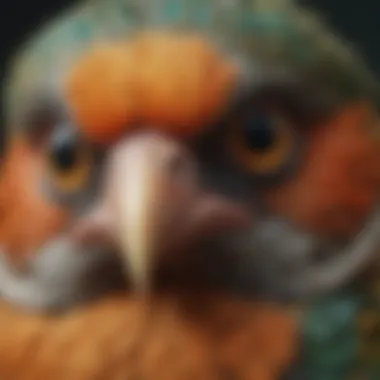
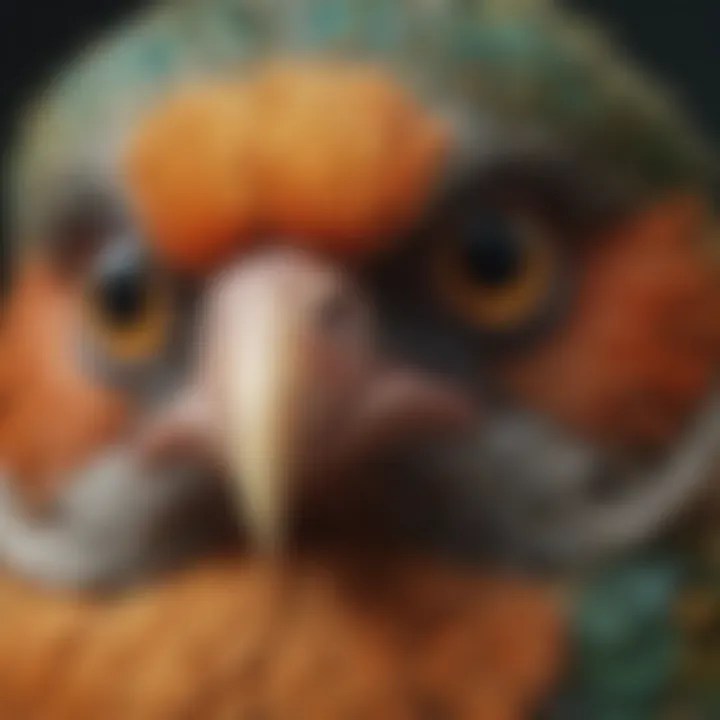
- Key Characteristic: Limited land area and isolation create unique evolutionary pressures, often resulting in bizarre adaptations.
- Benefit: Focusing on islands is beneficial for this article as they exemplify how geographical constraints can produce extraordinary bird species, such as the flightless Kakapo parrot.
- Unique Feature: While the isolation can protect bird species from some threats, it also leaves them vulnerable to invasive species and habitat loss. This juxtaposition illustrates the delicate balance that conservationists must consider.
Migration Patterns
Seasonal Movements
Seasonal movements are a remarkable aspect of bird behavior, particularly for unusual species that migrate to find optimal conditions for feeding and breeding. These patterns of migration are often finely tuned to seasonal changes in climate and resource availability.
- Key Characteristic: Many unusual birds, such as the Arctic Tern, undertake extensive migratory routes spanning thousands of miles.
- Benefit: Including migration patterns in our discussion highlights how these long voyages are not just about survival but also critical for genetic diversity and population stability.
- Unique Feature: A challenging aspect of seasonal movements is the reliance on ecological corridors; if these are disrupted, numerous species could be at risk.
Breeding Grounds
Breeding grounds are crucial for the propagation of unusual birds, as they often dictate the success of breeding cycles and subsequent generations. These spaces are not just geographic locations but rich ecosystems that provide the necessary resources for nesting and raising young.
- Key Characteristic: Many unusual birds choose breeding grounds based on the availability of specific food sources and safety from predators.
- Benefit: Investigating breeding grounds within this article allows for an exploration into how different environments shape reproductive success, further enforcing the significance of habitat preservation.
- Unique Feature: The specificity of breeding grounds also presents a drawback—if a location becomes inhospitable due to environmental changes, entire populations might be adversely affected.
Conservation Challenges
Understanding the conservation challenges that unusual birds face is pivotal. This section digs into the complexities surrounding the threats these species encounter, as well as the various efforts aimed at safeguarding their survival. By emphasizing the unique pressures placed on these birds, we also highlight the essential link between their fate and broader ecological health.
Threats to Unusual Birds
Habitat Loss
Habitat loss is a pressing issue impacting unusual bird species across the globe. As urban development expands and agricultural practices intensify, many birds lose their homes. The decline in forested areas, wetlands, and coastal regions threatens their breeding sites and feeding grounds.
What’s particularly concerning is how quickly these changes occur. Birds like the California Condor, once abundant, have seen their habitats shrink dramatically, significantly reducing their population. This aspect of habitat loss cannot be understated as it represents a fundamental barrier to the survival of many unique avian species.
- Key Characteristics: Habitat loss is often irreversible, leading to fragmentation that isolates populations, making it difficult for them to mate successfully.
- Advantages/Disadvantages: While some species may adapt briefly, the long-term effects can be devastating. Understanding this provides a sobering backdrop against which the need for conservation becomes clear.
Climate Change
Climate change stands as another formidable foe for unusual birds. Rising temperatures and erratic weather patterns disrupt the delicate balance of their habitats. For instance, birds relying on specific migration routes are finding it increasingly challenging due to changing climates.
Sea-level rise threatens shorebird nesting sites, while warmer winters can alter food availability for many species.
- Key Characteristics: The impact of climate change is widespread, affecting everything from breeding cycles to the distribution of food sources.
- Advantages/Disadvantages: While some species may shift their ranges to more hospitable environments, others, especially those with limited mobility or specialized habitat needs, face existential threats.
Conservation Efforts
Protected Areas
Protected areas are vital for the conservation of unusual bird species. These designated regions offer safe havens where birds can thrive without the pressures of human encroachment. Bird reserves, wildlife parks, and national forests often become the last bastions for threatened avian populations.
- Key Characteristics: They provide crucial habitats that help maintain genetic diversity and viable populations.
- Advantages/Disadvantages: The benefits are clear, but the establishment and maintenance of these areas can sometimes lead to conflicts with local communities on land use and resource allocation.
Restoration Initiatives
Restoration initiatives are essential efforts aimed at rehabilitating degraded habitats. Projects often focus on replanting native vegetation, removing invasive species, and restoring wetland areas. By rebuilding these ecosystems, we provide unusual birds with a lifeline.
- Key Characteristics: These initiatives require a combination of science and community engagement to succeed.
- Advantages/Disadvantages: While the potential for success is promising, these efforts can be resource-intensive and require long-term commitment. The rewards, however, can be significant as they not only benefit birds but also restore ecological balance.
"The fight for the survival of unusual birds is not just a race against time, but a reflection of our own environmental stewardship. Every effort counts, no matter how small."
"The fight for the survival of unusual birds is not just a race against time, but a reflection of our own environmental stewardship. Every effort counts, no matter how small."
Through understanding these conservation challenges and efforts, we begin to grasp the intricate dance between humanity and the avian world. The survival of unusual birds hinges not only on immediate actions but on sustained commitment to their habitats and ecological roles.
Case Studies of Notable Unusual Birds
Examining case studies of notable unusual birds provides a window into the diverse adaptations and behaviors that make these creatures unique. Each bird serves as a representative, highlighting particular survival strategies and their intricate connections within ecosystems. By studying these exceptional species, researchers and enthusiasts gain insights into the evolutionary pressures they face and the conservation measures necessary to protect them. This section emphasizes not only individual avian stories but also the broader implications for biodiversity and ecological health.
The Kakapo Parrot
Habitat and Behavior
The Kakapo parrot exemplifies adaptation in a unique way. This flightless bird inhabits the forests of New Zealand, favoring dense undergrowth where it can blend in and escape from predators. Its nocturnal nature, combined with a very distinct mating ritual, makes it stand out in the avian world. Each breeding season, male Kakapos engage in a unique courtship display, using deep booming sounds that resonate through the forest. This ritual is not just captivating; it serves as a vital for mating and sustaining the population.
The Kakapo's behavior of being largely ground-dwelling adds an interesting twist to its life cycle. Since they cannot fly, they have developed robust climbing skills, often residing in trees to forage on fruits and flowers. This characteristic is a double-edged sword; it allows them to evade some predators while exposing them to other threats due to limited escape options.
Conservation Status
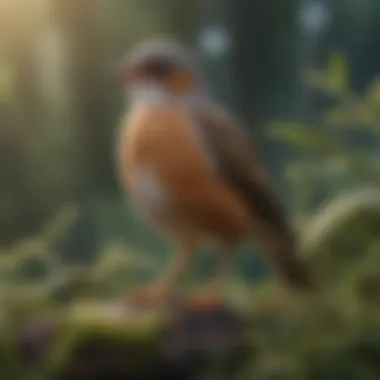
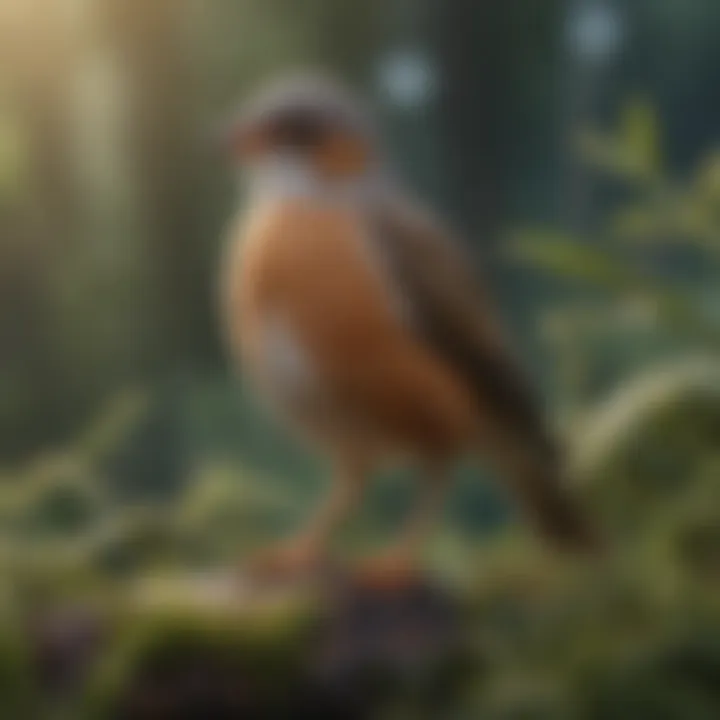
The conservation status of the Kakapo is critically endangered, a reflection of the severe challenges this species faces. Once abundant, habitat destruction and the introduction of predators like stoats and rats led to drastic population declines. Conservation efforts have ramped up in recent years, focusing on breeding programs and habitat restoration.
What stands out about the Kakapo's conservation strategy is the intensive management by wildlife organizations. Each Kakapo is monitored closely, and their genetic diversity is managed meticulously to ensure a healthy population. This approach not only aids the Kakapo but serves as a model for conserving other endangered species. Yet, despite these efforts, the road to recovery remains bumpy, highlighting the ongoing struggle for this fascinating parrot.
The Shoebill Stork
Distinctive Features
The Shoebill stork, with its massive, shoe-shaped bill, captures attention. This peculiar feature isn't just for show; it is perfectly suited for its diet, primarily consisting of fish and other small aquatic animals. The stork's bill allows it to catch prey with surgical precision, making it a highly effective hunter in its swampy habitats.
Another distinctive characteristic of the Shoebill is its stoic demeanor. Unlike many birds that flit about, Shoebills are known for their patience, often standing still for long periods as they wait for fish to come into reach. This behavior highlights the bird’s unique adaptation to its environment, showcasing its ability to thrive where others might struggle.
Ecological Role
The Shoebill stork plays a significant ecological role, acting as both predator and indicator species. By controlling fish populations in their wetlands, they help maintain the balance in these ecosystems. Their presence can indicate the health of the wetland environment, making them crucial for bioindicators in conservation efforts.
However, the Shoebill stork faces significant threats, including habitat loss and human encroachment on wetlands. Conservation measures that focus on protecting their habitats and promoting sustainable land use are critical for their survival. Their striking appearance and ecological importance make them a popular subject of study for ornithologists and conservationists alike.
"Each unusual bird tells a story about resilience and adaptation—an inspiration to us all in the face of challenges."
"Each unusual bird tells a story about resilience and adaptation—an inspiration to us all in the face of challenges."
In summary, these case studies illustrate the unique features and vital roles of the Kakapo parrot and the Shoebill stork, enhancing our understanding of unusual birds. Their individual narratives contribute to the wider conservation dialogue, underscoring the need for continued efforts in wildlife protection and ecological balance.
Cultural Significance of Unusual Birds
The fascinating world of unusual birds extends beyond their physical characteristics and ecological function. These unique creatures occupy a notable place in human culture, weaving their way into art, mythology, and local traditions. Understanding their cultural significance not only enhances our appreciation of biodiversity but also underscores the intricate relationships between humans and the avian species that inhabit our planet.
Symbolism in Art and Mythology
Birds have long been symbols in art and mythology, serving as potent reminders of the connection between mankind and the natural world. In various cultures, unusual birds frequently embody specific traits or concepts. For instance, the vivid plumage of the quetzal, a bird revered in Mesoamerican culture, symbolizes freedom and beauty. Artworks depicting the quetzal often communicate themes of resilience and hope — a sentiment deeply ingrained in the local identity.
Similarly, the mythology of the phoenix, a legendary bird that is reborn from its ashes, illustrates themes of transformation and renewal. Such narratives emphasize the importance of birds in storytelling, imparting lessons that reflect human experiences.
- Unusual birds often serve as:
- Mesmerizing subjects in various art forms, from paintings to sculptures.
- Motifs in folklore and traditions, often representing vital life lessons.
- Symbols of divine messages or omens, influencing cultural practices and beliefs.
"Birds are the messengers of the divine, carrying secrets of the earth and sky."
— Ancient Proverb
"Birds are the messengers of the divine, carrying secrets of the earth and sky."
— Ancient Proverb
Role in Local Ecosystems and Traditions
The role of unusual birds transcends their symbolic importance; they are crucial components in local ecosystems and play significant parts in cultural traditions. Many indigenous communities view certain birds as totems, believing they possess spiritual significance. For example, the bald eagle in Native American cultures symbolizes strength, courage, and wisdom, often being integrated into rituals and ceremonies.
Unusual birds also contribute to the health of their ecosystems. Their presence indicates a balanced environment, while their absence can signal ecological distress. Farmers and local communities often prioritize bird conservation, recognizing their roles in pest control, pollination, and seed dispersal. In some regions, various species are celebrated through festivals and events, fostering a communal respect for avian life.
- Notable examples of cultural integration:
- Traditional festivals dedicated to avian species, enhancing awareness of their role in nature and the ecosystem.
- Culinary practices that utilize birds while promoting sustainable harvesting methods.
In sum, the cultural significance of unusual birds is multi-faceted — spanning artistic expression, spiritual beliefs, and essential ecological functions. This rich tapestry of connections emphasizes the need for their protection and conservation, as our futures are intertwined with the fate of these remarkable creatures.
Future Directions in Avian Research
The field of avian research is on the cusp of transformation, embracing a variety of novel techniques and methodologies. As unusual birds capture our collective imagination, it’s crucial to recognize not just their importance in our ecosystems but also the role of innovative research in conserving these unique species. Future studies in this domain promise to unravel the complexities of bird life and offer clues to tackle conservation challenges.
Technological Advances in Ornithology
Recent years have seen remarkable progress in the technology we use to study birds. High-resolution tracking devices, like GPS and geolocators, allow researchers to monitor the migratory patterns of various species with unmatched precision. For instance, utilizing such technology has shed light on the migratory routes of the tiny ruby-throated hummingbird, revealing unexpected stopover sites and feeding habits that weren’t previously understood.
Moreover, advances in genomics are generating insights into the evolutionary history of birds. Technologies like CRISPR are not only helping scientists understand the genetic underpinnings of unique traits, but are also shedding light on how these adaptations might be leveraged for conservation efforts. It is not far-fetched to imagine a future where gene editing could play a role in safeguarding endangered species by enhancing their resilience to environmental changes.
In addition to these tools, citizen science platforms, such as eBird and iNaturalist, engage bird enthusiasts to contribute valuable observations. This collaboration provides a wide-reaching data pool that supports scientific studies while fostering a community passionate about unusual birds.
Interdisciplinary Approaches to Conservation
To effectively curb the threats faced by rare avian species, conservation efforts must extend beyond traditional biology and into other disciplines. Current problems, such as habitat loss due to urbanization or agriculture, demand cooperative strategies that involve sociologists, economists, and urban planners working alongside ornithologists. Identifying socio-economic factors impacting bird populations can lead to more sustainable land use policies.
For example, incorporating local community knowledge into conservation strategies has proven effective in diverse settings. By engaging with indigenous populations, researchers gain unique insights into historical bird populations and habitats that may have been overlooked.
Furthermore, understanding the cultural significance of certain species informs conservation priorities. When people comprehend how unique birds impact local traditions and ecosystems, they might be more likely to support conservation initiatives.
"Birds play a critical role not only in their ecosystems but also in the cultural narratives of people around the world. Their preservation requires a harmonized effort across various disciplines."
"Birds play a critical role not only in their ecosystems but also in the cultural narratives of people around the world. Their preservation requires a harmonized effort across various disciplines."
Such interdisciplinary approaches not only enhance the effectiveness of conservation efforts but also foster a broader understanding of the interconnection between humans and unusual birds, highlighting the need for collaboration across sectors to safeguard these magnificent creatures for generations to come.



